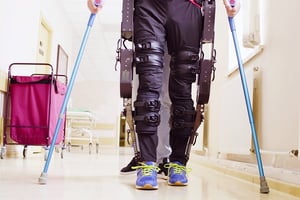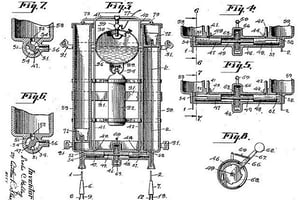 For over 130 years, engineers have sought to assist those who struggle with walking through the use of wearable mobile machines called exoskeletons. Many and varied power sources have been trialled for these machines over time, from compressed gas bags to steam power. So, what led to batteries being selected as the modern-day power source of choice and will they still be relied upon in the future?
For over 130 years, engineers have sought to assist those who struggle with walking through the use of wearable mobile machines called exoskeletons. Many and varied power sources have been trialled for these machines over time, from compressed gas bags to steam power. So, what led to batteries being selected as the modern-day power source of choice and will they still be relied upon in the future?
Power problems in the early years
 In 1890, the world’s first exoskeleton-like device used energy stored in compressed gas bags to assist in movement. However, it still required human power to function, therefore making it unsuitable for assisting in the rehabilitation of individuals with no use of their legs.
In 1890, the world’s first exoskeleton-like device used energy stored in compressed gas bags to assist in movement. However, it still required human power to function, therefore making it unsuitable for assisting in the rehabilitation of individuals with no use of their legs.
Therefore, the next known exoskeleton allowed human power to be supplemented by external power. Known as a ‘pedometer’ (shown in Fig 2 to Fig 8), it was invented in 1917 and used steam to move artificial ligaments in parallel to the wearer’s movements. However, the time and effort it took to produce steam meant that the exoskeleton was not readily available or easy to use.
Moving ahead to 48 years later, General Electric (alongside the US Armed Forces) attempted to use a combination of hydraulics and electricity to power their ‘Hardiman’ exoskeleton. However, these forms of power caused the exoskeleton to move violently and uncontrollably, so no human tests were ever conducted. Engineer Ralph Mosher commented that, “Without getting all the components to work together the practical uses for the Hardiman project were limited.”
Also experiencing problems with powering an exoskeleton, at around the same time, were engineers at the Mihajlo Pupin Institute in Serbia. Their exoskeleton was actuated by DC motors; however, the device’s portability was limited by the motor, battery and computer technology of the time. Nevertheless, it was the most effective power solution to date, resulting in smoother motion and better tracking ability than its predecessors. There were even successful cases of patients with varying degrees of paralysis being able to walk using the complete exoskeleton with support from crutches.
The shift towards battery power
Yet, it is the portability and readily available power of batteries that have become the modern-day manufacturers' power source of choice – allowing exoskeletons to be successfully used in the medical, logistics and military sectors.
Early battery powered exoskeletons, such as the Raytheon XOS, suffered from short run-times, meaning they could only use batteries for up to 40 minutes at a time. Their main power was drawn from electricity generated by an external power supply, thereby losing the device’s portability.
Engineers then began to seek ways to improve battery run-times. Although precise details of Lockheed Martin’s ‘Human Universal Load Carrier (HULC)’ military exoskeleton were top secret, it was rumoured that ‘HULC’ would allow the wearer to recharge the battery using the force generated by walking, resulting in a device that could operate for more than 20 hours. Work started in the year 2000 but, despite more than eight years of development, this project was shelved after it was found to increase strain on the wearer's muscles, the opposite of its intended purpose to reduce the strain suffered by soldiers who carry heavy loads in the field.
Commercial success at last
It was only a matter of time before a suitable battery and exoskeleton were combined. Perhaps the most successful on the market today is the ReWalk exoskeleton – a battery-powered light, wearable bionic walking assistance system that uses motors at the hip and knee joints. Used in the rehabilitation of patients with spinal cord injury, ReWalk is powered by a rechargeable lithium-ion battery that is housed in a backpack and lasts for up to 8 hours from a single charge. Following FDA approval for home and public use in 2014, ReWalk became one of the first exoskeletons to be available for daily, unsupervised use (selling over 100 in 2 years).
Another successful exoskeleton for rehabilitation is Indego by Parker Hannifin, which uses a long-lasting, quick-change rechargeable battery that allows for continuous use throughout the day. In the event of a power failure, safety features have been incorporated to lock the knee joints. In 2016, the FDA approved the device for clinical and personal use.
Looking to the future
As exoskeletons continue to incorporate batteries that allow for longer running times, use of these devices will only increase, as more become certified for use in home and professional environments.
One device may be able to succeed where ‘HULC’ failed and come to the aid of the military. Currently in pre-production by SARCOS for the United States Special Operations Command (USSOCOM); ‘Guardian XO’ is powered by hot swappable, rechargeable battery packs – each of which can last for up to eight hours. In a statement from SARCOS, the company stated that developments in battery technology have contributed towards its ability to make the exoskeleton.
“The first prototype 10 years ago was hydraulically powered and drew 6,000 watts,” SARCOS’ chief marketing officer Kristi Martindale said. “Now it’s less than 400 watts of power for the whole suit.”
It is clear that battery performance is crucial to the continued success of exoskeletons. Speaking to a battery manufacturer like Accutronics can ensure that original equipment manufacturers get the right portable power for their requirements – for example, weight, capacity, cycle life and much more can be considered. Where an off-the-shelf battery is unsuitable, a custom battery could be innovated, paving the way for the exoskeletons of tomorrow.



